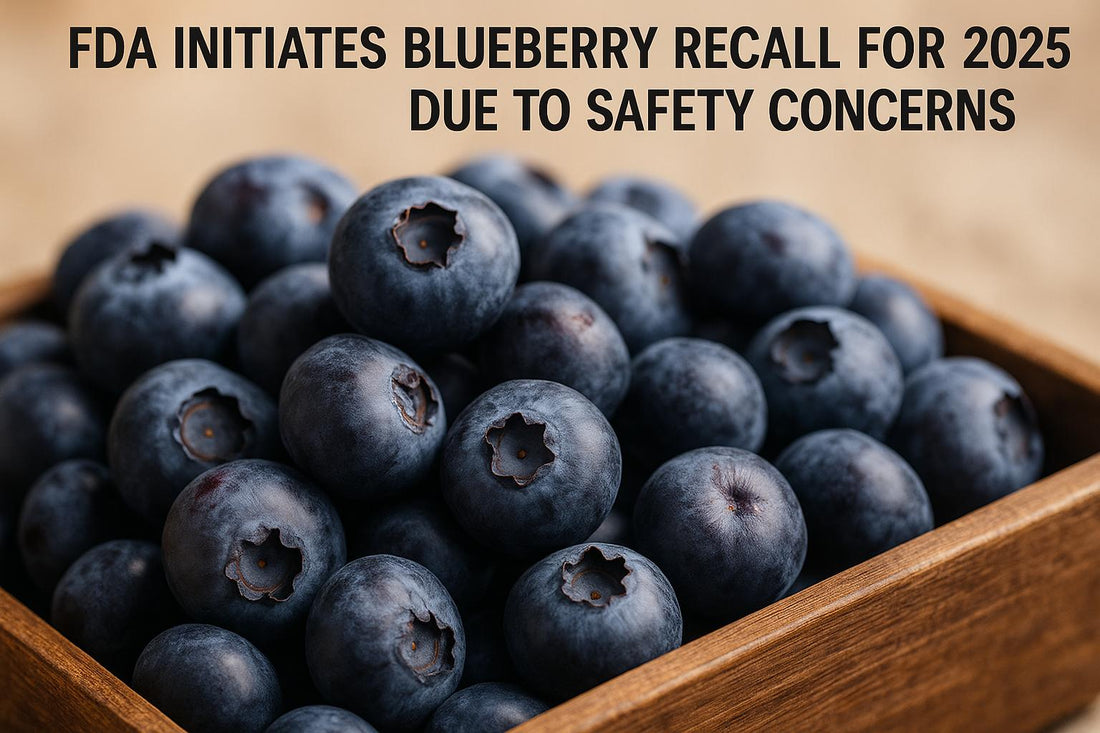
FDA Initiates Blueberry Recall for 2025 Due to Safety Concerns
Share
A nationwide recall of fresh blueberries has been initiated by the U.S. Food and Drug Administration (FDA) in 2025 due to widespread contamination concerns. More than 20 million pounds of blueberries were affected by the recall, which stemmed from bacterial contamination linked to multiple U.S. states. This large-scale recall has had far-reaching impacts on public health, the agricultural sector, and the nation’s supply chain.
Contamination Identified Across Major U.S. States
The recall began on March 9, 2025, after the FDA identified contamination in multiple batches of fresh blueberries, with bacteria including Salmonella, Listeria monocytogenes, and E. coli. The contamination was linked to blueberries originating from major production regions such as Michigan, Oregon, Maine, and California. The Centers for Disease Control and Prevention (CDC) confirmed that these contaminated shipments caused over 430 suspected illnesses, 190 of which were laboratory-confirmed.
Between March 10 and March 18, state health agencies and the CDC worked to trace the contamination, issuing public alerts and urging the disposal of affected products. By March 20, major distributors had withdrawn contaminated blueberries from supermarket chains across the country.
Public Health Impacts Highlight Food Safety Challenges
The contaminated blueberries caused a series of foodborne illness outbreaks characterized by severe gastrointestinal symptoms. People impacted by the outbreak reported stomach cramps, nausea, vomiting, and, in some cases, fever and dehydration. Vulnerable populations, such as children, seniors, and those with compromised immune systems, were particularly affected, with some cases requiring hospitalization.
The outbreak shed light on gaps in food safety management, including the need for more robust detection systems and improved contamination prevention measures. "Blueberry recall 2025 impacted more than 30% of major U.S. supply chains, disrupting nationwide distribution", according to investigations following the recall.
Investigations Uncover Causes of Contamination
An FDA and CDC-led investigation revealed that the contamination risks were exacerbated by several factors, including climate variations during the 2025 growing season. Unseasonal rainfall and high humidity created ideal conditions for bacterial growth, particularly during harvesting, packing, and distribution stages.
The delicate nature of blueberries, with their thin skin and high moisture content, made them especially vulnerable to contamination. Additionally, lapses in Good Agricultural Practices (GAP), such as inadequate water quality management and worker hygiene protocols, were identified as contributing factors.
Delays in real-time microbial testing and traceability further complicated efforts to intercept contaminated batches before they reached consumers. This highlighted the broader need for enhanced surveillance and rapid reporting systems in agricultural supply chains.
Economic Losses and Supply Chain Disruptions
The blueberry recall not only posed health risks but also led to significant economic losses and logistical challenges. More than 30% of the national blueberry supply chain was disrupted, affecting growers, distributors, and retailers alike. Major agricultural states such as Michigan, Oregon, Maine, and California experienced severe economic fallout, particularly small and medium-sized farms that struggled to absorb the financial impact.
In total, the economic losses resulting from the recall were estimated to fall between $250 million and $400 million. Distributors faced logistical bottlenecks as they worked to trace contaminated shipments, withdraw affected products, and redirect unaffected produce to retailers. The recall forced stakeholders across the industry to re-evaluate quality assurance processes and supply chain transparency.
Strengthening Food Safety Protocols Post-Recall
In response to the recall, government agencies and agricultural stakeholders have taken steps to strengthen food safety protocols and reduce the risk of future contamination. Key measures include:
- Enhanced Good Agricultural Practices (GAP): Improvements in water quality monitoring, worker hygiene training, and sanitation protocols at packing facilities.
- Technology Adoption: The integration of real-time microbial detection systems, satellite-enabled crop monitoring, and blockchain-based traceability platforms.
- Sustainable Farming Practices: Investments in disease-resistant blueberry varieties and advancements in post-harvest handling techniques to prevent contamination.
The recall also prompted discussions about the need for stricter regulatory enforcement, including more frequent audits and mandatory use of advanced traceability systems for perishable produce.
Lessons for the Agricultural Industry
The 2025 blueberry recall serves as a stark reminder of the vulnerabilities in the nation’s food production and supply chain systems. While the immediate health risks were addressed, the event has sparked a broader push toward innovation and collaboration within the agricultural industry. By adopting advanced technology, strengthening regulatory frameworks, and prioritizing transparency, the industry can better safeguard public health and rebuild consumer trust in fresh produce.
As the agricultural sector moves forward, these lessons will play a critical role in ensuring the safety and resilience of food supply systems.
Read the source
